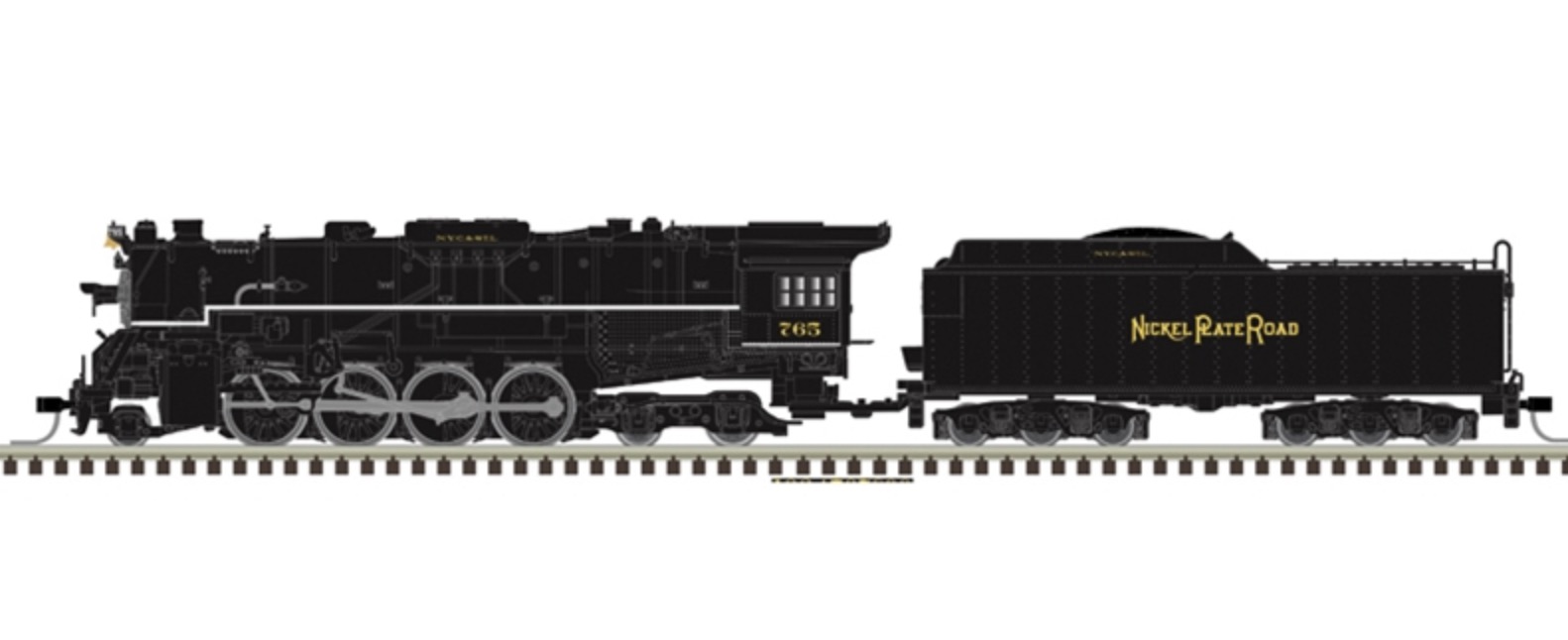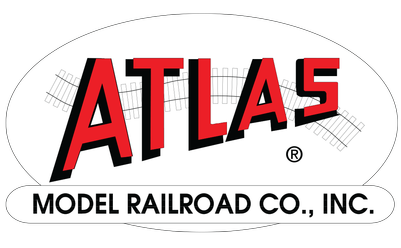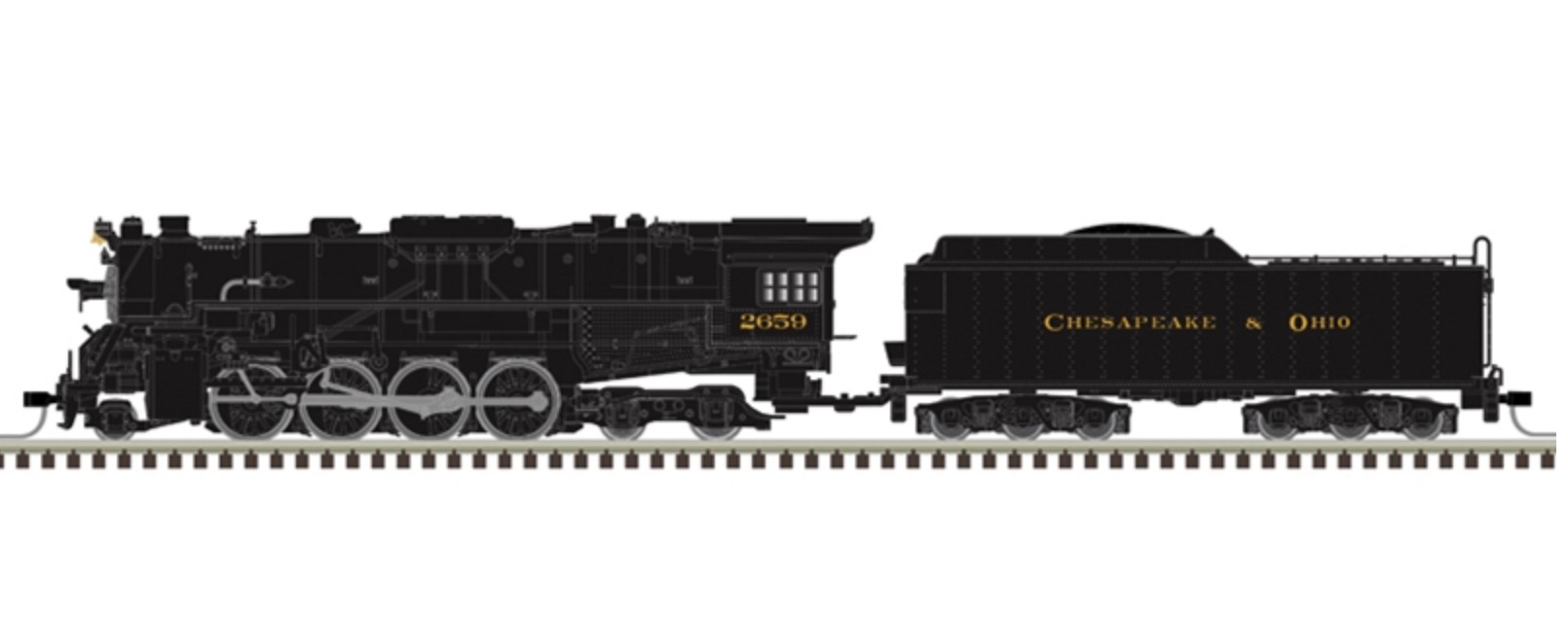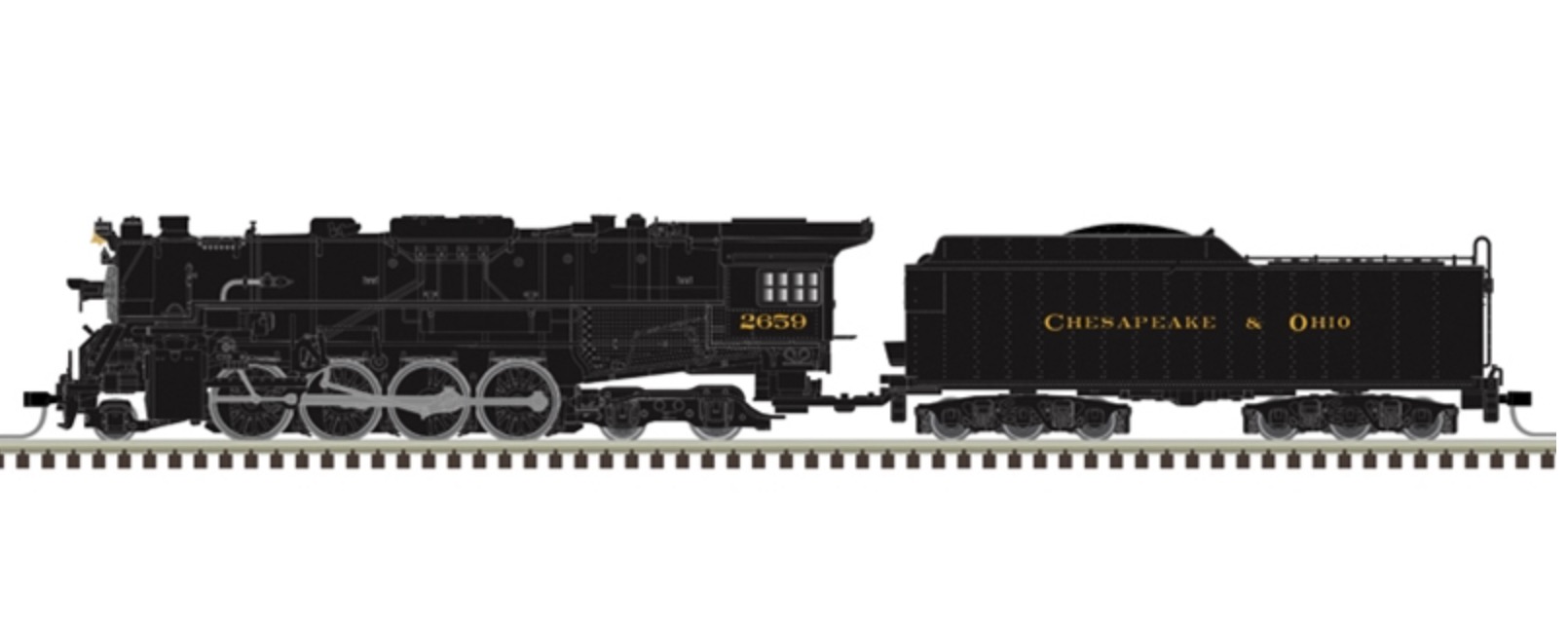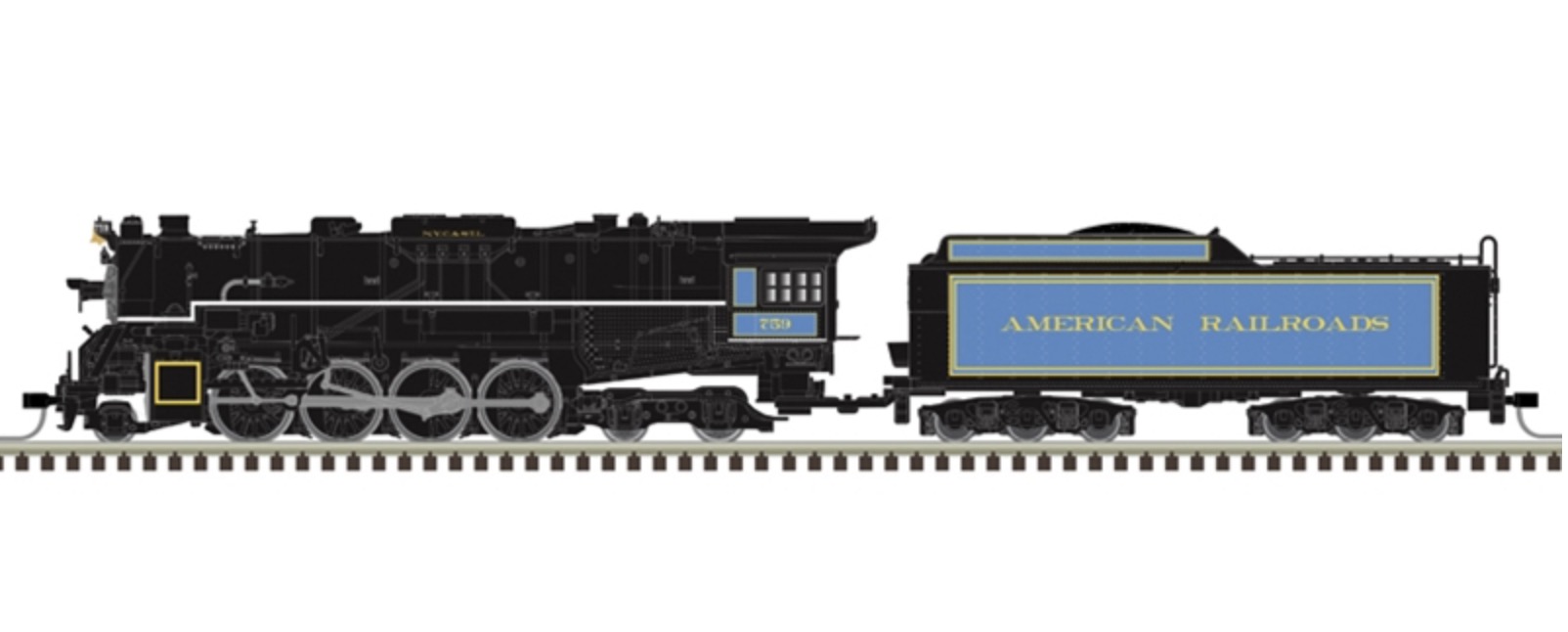Model Information: In the spring of 1925, the Berkshire Hills on the Boston and Albany railroad resounded with the roar of a new concept in locomotive design – the first “Super-Power” 2-8-4. Dubbed the A-1 by Lima Locomotive Works, the “Berkshire” - as it quickly came to be known - was more than a logical upgrade to the 2-8-2 “Mikado”, as it featured a larger boiler, firebox, feedwater heater and superheater. These features taken together overcame the issues of wheel slip and loss of steam pressure upon acceleration that plagued earlier drag-freight designs based on the Mikado.
Indeed, this first Berkshire easily pulled over 2500 tons up the 1.5% grades of the B&A without assistance, resulting in an order for 55 by the B&A alone. More upgrades were soon to come, however. By the early 1930s, the railroads under the ownership of the Van Swerigen brothers (Nickel Plate, Chesapeake & Ohio and Hocking Valley, Erie, Pere Marquette, Wheeling & Lake Erie) had joined together the engineering talents of their several railroads into an Advisory Mechanical Committee, which produced many of the most successful steam locomotives of the era, including the C&O T-1 (or “Texas” type). The improved Berkshire design resulting from this committee was derived from scaling the primary dimensions of the T-1 down by 70% - except for the drivers, which were increased in size from 63” to 69”. By the end of production of the 2-8-4 Berkshire in 1949, Lima had produced 368 of the 611 locomotives to carry the name. Two remain in operation – NKP 765 (the “Queen of the West”) and PM 1225, the star of the movie “Polar Express”.
Indeed, this first Berkshire easily pulled over 2500 tons up the 1.5% grades of the B&A without assistance, resulting in an order for 55 by the B&A alone. More upgrades were soon to come, however. By the early 1930s, the railroads under the ownership of the Van Swerigen brothers (Nickel Plate, Chesapeake & Ohio and Hocking Valley, Erie, Pere Marquette, Wheeling & Lake Erie) had joined together the engineering talents of their several railroads into an Advisory Mechanical Committee, which produced many of the most successful steam locomotives of the era, including the C&O T-1 (or “Texas” type). The improved Berkshire design resulting from this committee was derived from scaling the primary dimensions of the T-1 down by 70% - except for the drivers, which were increased in size from 63” to 69”. By the end of production of the 2-8-4 Berkshire in 1949, Lima had produced 368 of the 611 locomotives to carry the name. Two remain in operation – NKP 765 (the “Queen of the West”) and PM 1225, the star of the movie “Polar Express”.
Prototype History: Under the Whyte notation, a 2-8-4 is a steam locomotive that has one unpowered leading axle, usually in a leading truck, followed by four powered and coupled driving axles, and two unpowered trailing axles, usually mounted in a bogie. This locomotive type is most often referred to as a Berkshire, though the Chesapeake and Ohio Railway used the name Kanawha for their 2-8-4s. In Europe, this wheel arrangement was mostly seen in mainline passenger express locomotives and, in certain countries, in tank locomotives. Locomotives of a 2-8-4 wheel arrangement were used mainly for hauling fast express freight trains on heavy freight service. They often replaced older 2-8-2 Mikados where more power was required. In turn, they were often replaced by even more powerful 2-10-4 Texas type locomotives.
In the USA, the Berkshire type's big boost came in 1934, when the New York, Chicago and St. Louis Railroad (Nickel Plate Road or NKP) received its first 2-8-4s, built to a new design from the Advisory Mechanical Committee (AMC) of the Van Sweringen empire. Under the Van Sweringen umbrella were the Nickel Plate Road, Erie Railroad, Chesapeake and Ohio Railway and Pere Marquette Railway.
From Wikipedia
Read more on American-Rails.com
In the USA, the Berkshire type's big boost came in 1934, when the New York, Chicago and St. Louis Railroad (Nickel Plate Road or NKP) received its first 2-8-4s, built to a new design from the Advisory Mechanical Committee (AMC) of the Van Sweringen empire. Under the Van Sweringen umbrella were the Nickel Plate Road, Erie Railroad, Chesapeake and Ohio Railway and Pere Marquette Railway.
From Wikipedia
Read more on American-Rails.com
Road Name History:  The New York, Chicago and St. Louis Railroad (reporting mark NKP), abbreviated NYC&St.L, was a railroad that operated in the mid-central United States. Commonly referred to as the Nickel Plate Road, the railroad served a large area, including trackage in the states of New York, Pennsylvania, Ohio, Indiana, Illinois and Missouri. Its primary connections included Buffalo, Chicago, Cincinnati, Cleveland, Indianapolis, St. Louis, and Toledo.
The New York, Chicago and St. Louis Railroad (reporting mark NKP), abbreviated NYC&St.L, was a railroad that operated in the mid-central United States. Commonly referred to as the Nickel Plate Road, the railroad served a large area, including trackage in the states of New York, Pennsylvania, Ohio, Indiana, Illinois and Missouri. Its primary connections included Buffalo, Chicago, Cincinnati, Cleveland, Indianapolis, St. Louis, and Toledo.
The Nickel Plate Railroad was constructed in 1881 along the South Shore of the Great Lakes connecting Buffalo and Chicago to compete with the Lake Shore and Michigan Southern Railway. In 1964 the Nickel Plate Road and several other mid-western carriers were merged into the larger Norfolk and Western Railway (N&W). The goal of the N&W expansion was to form a more competitive and successful system serving 14 states and the Canadian province of Ontario on more than 7,000 miles (11,000 km) of railroad. The profitable N&W was itself combined with the Southern Railway, another profitable carrier, to form Norfolk Southern Corporation (NS) in 1982.
At the end of 1960 NKP operated 2,170 miles (3,490 km) of road on 4,009 miles (6,452 km) of track, not including the 25 miles (40 km) of Lorain & West Virginia. That year it reported 9758 million net ton-miles of revenue freight and 41 million passenger-miles.
The Nickel Plate Historical and Technical Society works to preserve the memory of the Nickel Plate Road.
From WIkipedia

The Nickel Plate Railroad was constructed in 1881 along the South Shore of the Great Lakes connecting Buffalo and Chicago to compete with the Lake Shore and Michigan Southern Railway. In 1964 the Nickel Plate Road and several other mid-western carriers were merged into the larger Norfolk and Western Railway (N&W). The goal of the N&W expansion was to form a more competitive and successful system serving 14 states and the Canadian province of Ontario on more than 7,000 miles (11,000 km) of railroad. The profitable N&W was itself combined with the Southern Railway, another profitable carrier, to form Norfolk Southern Corporation (NS) in 1982.
At the end of 1960 NKP operated 2,170 miles (3,490 km) of road on 4,009 miles (6,452 km) of track, not including the 25 miles (40 km) of Lorain & West Virginia. That year it reported 9758 million net ton-miles of revenue freight and 41 million passenger-miles.
The Nickel Plate Historical and Technical Society works to preserve the memory of the Nickel Plate Road.
From WIkipedia
Brand/Importer Information: In 1924 Stephan Schaffan, Sr. founded the Atlas Tool Company in Newark, New Jersey. In 1933 his son, Stephan Schaffan, Jr., came to work for his father at the age of sixteen. Steve Jr. built model airplanes as a hobby and frequented a local hobby shop. Being an enterprising young man, he would often ask the owner if there was anything he could do to earn some extra spending money. Tired of listening to his requests, the hobby-store owner threw some model railroad track parts his way and said, "Here, see if you can improve on this".
In those days, railroad modelers had to assemble and build everything from scratch. Steve Jr. created a "switch kit" which sold so well, that the entire family worked on them in the basement at night, while doing business as usual in the machine shop during the day.
Subsequently, Steve Jr. engineered the stapling of rail to fiber track, along with inventing the first practical rail joiner and pre-assembled turnouts and flexible track. All of these products, and more, helped to popularize model railroading and assisted in the creation of a mass-market hobby. The budding entrepreneur quickly outgrew the limitations of a basement and small garage operation. Realizing they could actually make a living selling track and related products, Steve and his father had the first factory built in Hillside, New Jersey at 413 Florence Avenue in 1947. On September 30, 1949, the Atlas Tool Company was officially incorporated as a New Jersey company.
In 1985, Steve was honored posthumously for his inventions by the Model Railroad Industry Association and was inducted into the Model Railroad Industry Hall of Fame in Baltimore, Maryland. In addition, Steve was nominated and entered into the National Model Railroad Association Pioneers of Model Railroading in 1995.
In the early 1990s, the Atlas Tool Company changed its name to Atlas Model Railroad Company, Inc.
In those days, railroad modelers had to assemble and build everything from scratch. Steve Jr. created a "switch kit" which sold so well, that the entire family worked on them in the basement at night, while doing business as usual in the machine shop during the day.
Subsequently, Steve Jr. engineered the stapling of rail to fiber track, along with inventing the first practical rail joiner and pre-assembled turnouts and flexible track. All of these products, and more, helped to popularize model railroading and assisted in the creation of a mass-market hobby. The budding entrepreneur quickly outgrew the limitations of a basement and small garage operation. Realizing they could actually make a living selling track and related products, Steve and his father had the first factory built in Hillside, New Jersey at 413 Florence Avenue in 1947. On September 30, 1949, the Atlas Tool Company was officially incorporated as a New Jersey company.
In 1985, Steve was honored posthumously for his inventions by the Model Railroad Industry Association and was inducted into the Model Railroad Industry Hall of Fame in Baltimore, Maryland. In addition, Steve was nominated and entered into the National Model Railroad Association Pioneers of Model Railroading in 1995.
In the early 1990s, the Atlas Tool Company changed its name to Atlas Model Railroad Company, Inc.
Item created by: CNW400 on 2025-02-20 11:29:28. Last edited by CNW400 on 2025-02-20 11:29:29
If you see errors or missing data in this entry, please feel free to log in and edit it. Anyone with a Gmail account can log in instantly.
If you see errors or missing data in this entry, please feel free to log in and edit it. Anyone with a Gmail account can log in instantly.


